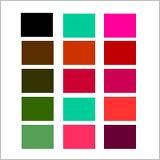



Precio FOB
Obtener el precio más reciente( Negotiable )
|5 Kilogram Minimum Order
País:
India
N º de Modelo:
-
Precio FOB:
( Negotiable ) Obtener el precio más reciente
Lugar de origen:
-
Precio de pedido mínimo:
-
Cantidad de pedido mínimo:
5 Kilogram
Detalle de embalaje:
As specified by the customer
El tiempo de entrega:
15 to 20 Days
Capacidad de suministro:
1000 Kilogram per Week
Tipo de pago:
T/T, L/C, D/A, D/P, Western Union, Money Gram
Grupo de productos :
-
India
Persona de contacto Mr. NIMESH
203,Sangath Apartment,Shilpinagar,kalanala, Bhavnagar, Gujarat
ACID DYES
Acid
dyes are water soluble anionic dyes that are applied to fibers
such as silk, wool, nylon and modified acrylic fibers from
neutral to acid dye baths. Attachment to the fiber is attributed,
at least partly, to salt formation between anionic groups in the
dyes and cationic groups in the fiber. Water soluble Acid dyes
are not substantive to cellulosic fibres. Acid dyes are used both
commercially and by the studio dyer to dye protein/animal fibers
such as wool, silk, mohair, angora, alpaca and some nylons and
synthetics. Acid dyes require the use of an acid such as vinegar,
acetic or sulphuric acid to set the color.
Acid dyes sound scary to some novices, who imagine that the dyes
themselves are caustic strong acids. In fact, the dyes are
non-caustic, are in many cases non-toxic, and are named for the
mild acid (such as vinegar) used in the dyeing process, and for
the types of bonds they form to the fiber. Some of them are
significantly more toxic than fiber reactive dyes, while others
are even safe enough to eat, and are sold as food
coloring.
Acid
dyes fall into several classes:
1. Leveling acid or strong acid dye,
2. Milling or weak acid dyes, and
3. Super milling or fast acid or neutral acid dyes.
They are also the acid dye component of all-purpose or union dyes such as Rit and Tintex, says Knutson. It's difficult now to find out which specific acid dyes fall into which of these dye classes, however. At least part of the reason is that the information is not particularly useful to the dyer.
Most
histologic dyes are classified either as acid or as basic dyes.
An acid dye exists as an anion (negatively charged) in solution,
while a basic dye exists as a cation (positive charge). For
instance, in the hematoxylin-eosin stain (H&E), the
hematoxylin-metal complex acts as a basic dye. The eosin acts as
an acid dye. A very large class of dyes containing acidic groups,
such as the sodium salts of sulfonic acids or phenolic groups.
They are more soluble and have less tinctorial value than basic
dyes but they also have greater light fastness. They do not form
lakes with tannin. Acid dyes are used in dyeing leather, paper,
etc., and their particular value lies in their ability to produce
brighter, more uniform colors. They are normally applied from an
acid dye liquor (acetic, formic, or sulphuric acid); however,
unless applied from a neutral or only slightly acid dyebath,
i.e., pH of 6.0 to 7.0, their use is likely to result in acid
degradation of the material dyed.
| País: | India |
| N º de Modelo: | - |
| Precio FOB: | ( Negotiable ) Obtener el precio más reciente |
| Lugar de origen: | - |
| Precio de pedido mínimo: | - |
| Cantidad de pedido mínimo: | 5 Kilogram |
| Detalle de embalaje: | As specified by the customer |
| El tiempo de entrega: | 15 to 20 Days |
| Capacidad de suministro: | 1000 Kilogram per Week |
| Tipo de pago: | T/T, L/C, D/A, D/P, Western Union, Money Gram |
| Grupo de productos : | - |